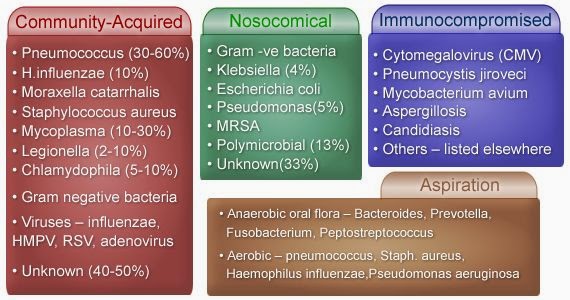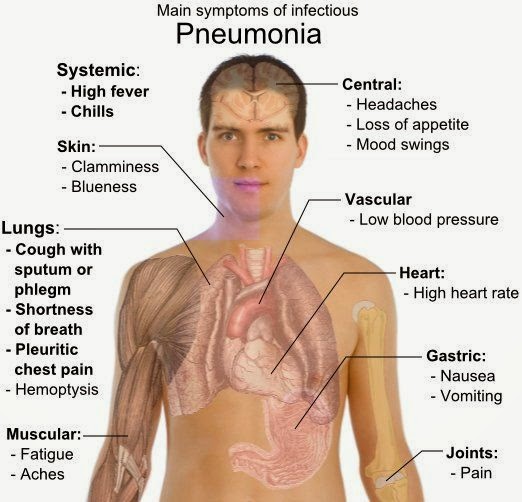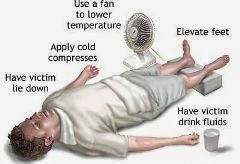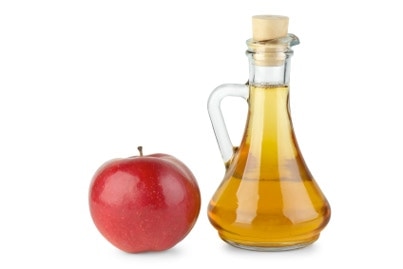Dictionary Meaning -
(according to Dorland's pocket medical Dictionary)
Pneumonia Al'ba - A Fatal Desquamative Pneumonia Of The Newborn Due To Congenital Syphilis, With Fatty Degeneration Of The Lungs.
Aspiration Pneumonia - That Due To Aspiration Of Foreign Material Into The Lungs.
Atypical Pneumonia - Primary Atypical Pneumonia.
Pathological Point Of View -
Causes :-


Mechanisms :-
Signs & Symptoms :-



Management :-


Homoeopathic Treatment :-
by Oscar E. BOERICKE, M.D.) Are As Below-
Stages of pneumonia
Consolidation -- Ant. t., Bry., Iod., Kali iod., Kali m., Phos., Sang., Sul.
Type
For Detail Study Of Above Mentioned Individual Remedy From HOMŒOPATHIC MATERIA MEDICA by William BOERICKE, M.D.:-
(according to Dorland's pocket medical Dictionary)
Inflammation Of The Lungs With Exudation And Consolidation.
Pneumonia Al'ba - A Fatal Desquamative Pneumonia Of The Newborn Due To Congenital Syphilis, With Fatty Degeneration Of The Lungs.
Aspiration Pneumonia - That Due To Aspiration Of Foreign Material Into The Lungs.
Atypical Pneumonia - Primary Atypical Pneumonia.
Bacterial Pneumonia - That Due To Bacteria, Usually Species Of Streptococcus, Staphylococcus, Klebsiella, And Mycoplasma.
Bronchial Pneumonia - Bronchopneumonia.
Desquamative Interstitial Pneumonia - Chronic Pneumonia With Desquamation Of Large Alveolar Cells And Thickening Of The Walls Of Distal Air Passages; Marked By Dyspnea And Non-Productive Cough.
Double Pneumonia - That Affecting Both Lungs.
Friedlander Pneumonia - Klebsiella Pneumonia.
Hypo-Static Pneumonia - A Type Seen In The Weak Or Elderly, Due To Excessive Lying On The Back.
Influenzal Pneumonia , Influenza Virus Pneumonia - An Acute, Usually Fatal Type Due To Influenza Virus, With High Fever, Prostration, Sore Throat, Aching Pains, Dyspnea, Massive Oedema, & Consolidation. It May Be Complicated By Bacterial Pneumonia.
Inhalation Pneumonia - 1. Aspiration Pneumonia.
2. Broncho Pneumonia Due To Inhalation Of Irritating Vapours.
Interstitial Pneumonia - 1. Any Of Various Types Of Pneumonia Characterized By Thickening Of The Interstitial Tissue.
2. Bronchopneumonia Due To Inhalation Of Irritating Vapours.
Interstitial Plasma Cell Pneumonia - Pneumocystis Pneumonia.
Klebsiella Pneumonia - Friedlander Pneumonia; A Form With Massive Mucoid Inflammatory Exudates In A Lobe Of The Lung, Due To Klebsiella Pneumoniae.
Lipid Pneumonia , Lipoid Pneumonia - Aspiration Pneumonia Due To Aspiration Of Oil.
Lobar Pneumonia - 1. Acute Bacterial Pneumonia With Oedema, Usually In One Lung; The Most Common Type Is Pneumococcal Pneumonia.
2. Pneumococcal Pneumonia.
Lobular Pneumonia - Bronchopneumonia.
Mycoplasmal Pneumonia - Primary Atypical Pneumonia Caused By Mycoplasma Pneumoniae.
Pittsburgh Pneumonia - A Type Resembling Legionnaires' Disease, Caused By Legionella Micdadei, Seen In Immuno-Compromised Patients.
Pneumococcal Pneumonia - The Most Common Type Of Lobar Pneumonia, Caused By Streptococcus Pneumoniae.
Pneumocystis Pneumonia - A Form Caused By Pneumocystis Jiroveci, Seen In Infants And Debilitated Or Immunocompromised Persons; Cellular Detritus Containing Plasma Cells Appears In Lung Tissue.
Pneumocystis Carinii Pneumonia - Former Name For Pneumocystis Pneumonia.
Primary Atypical Pneumonia - Any Of Numerous Types Of Acute Pneumonia, Caused By Bacteria Such As Species Of Mycoplasma, Rickettesia, Or Chlamydophila, Or Viruses Such As Adenoviruses Or Para-Influenza Virus.
Rheumatic Pneumonia - A Rare, Usually Fatal Complication Of Acute Rheumatic Fever, With Extensive Pulmonary Consolidation And Rapidly Progressive Functional Deterioration, Alveolar Exudate, Interstitial Infiltrates, And Necrotizing Arteritis.
Varicella Pneumonia - That Developing After The Skin Eruption In Varicella (Chicken Pox), Apparently Due To The Same Virus; Symptoms May Be Severe Chest Pain.
Viral Pneumonia - That Due To A Virus, e.g., Adenovirus, Influenza virus, Para-Influenza Virus, Or Varicella Virus.
White Pneumonia - Pneumonia Alba.
Mycoplasmal Pneumonia - Primary Atypical Pneumonia Caused By Mycoplasma Pneumoniae.
Pittsburgh Pneumonia - A Type Resembling Legionnaires' Disease, Caused By Legionella Micdadei, Seen In Immuno-Compromised Patients.
Pneumococcal Pneumonia - The Most Common Type Of Lobar Pneumonia, Caused By Streptococcus Pneumoniae.
Pneumocystis Pneumonia - A Form Caused By Pneumocystis Jiroveci, Seen In Infants And Debilitated Or Immunocompromised Persons; Cellular Detritus Containing Plasma Cells Appears In Lung Tissue.
Pneumocystis Carinii Pneumonia - Former Name For Pneumocystis Pneumonia.
Primary Atypical Pneumonia - Any Of Numerous Types Of Acute Pneumonia, Caused By Bacteria Such As Species Of Mycoplasma, Rickettesia, Or Chlamydophila, Or Viruses Such As Adenoviruses Or Para-Influenza Virus.
Rheumatic Pneumonia - A Rare, Usually Fatal Complication Of Acute Rheumatic Fever, With Extensive Pulmonary Consolidation And Rapidly Progressive Functional Deterioration, Alveolar Exudate, Interstitial Infiltrates, And Necrotizing Arteritis.
Varicella Pneumonia - That Developing After The Skin Eruption In Varicella (Chicken Pox), Apparently Due To The Same Virus; Symptoms May Be Severe Chest Pain.
Viral Pneumonia - That Due To A Virus, e.g., Adenovirus, Influenza virus, Para-Influenza Virus, Or Varicella Virus.
White Pneumonia - Pneumonia Alba.
Pathological Point Of View -
Pneumonia Is An Inflammatory Condition Of The Lung Affecting Primarily The Microscopic Air Sacs Known As Alveoli.
Causes :-


- Viruses.
- Fungi.
- Parasites.
- Idiopathic
Mechanisms :-
Pneumonia Frequently Starts As An Upper Respiratory Tract Infection That Moves Into The Lower Respiratory Tract.
- Viral :-
Viruses May Reach The Lung By A Number Of Different Routes.
|
\/Respiratory Syncytial Virus Is Typically Contracted When People Touch Contaminated Objects And Then They Touch Their Eyes Or Nose.
|
\/Other Viral Infections Occur When Contaminated Airborne Droplets Are Inhaled Through The Mouth Or Nose.
|
\/Once In The Upper Airway, The Viruses May Make Their Way In The Lungs, Where They Invade The Cells Lining The Airways, Alveoli, Or Lung Parenchyma.
|
\/Some Viruses Such As Measles And Herpes Simplex May Reach The Lungs Via The Blood.
|
\/The Invasion Of The Lungs May Lead To Varying Degrees Of Cell Death.
|
\/When The Immune System Responds To The Infection, Even More Lung Damage May Occur.
|
\/Primarily White Blood Cells, Mainly Mono Nuclear Cells, Generate The Inflammation.
|
\/As Well As Damaging The Lungs, Many Viruses Simultaneously Affect Other Organs And Thus Disrupt Other Body Functions.
|
\/Viruses Also Make The Body More Susceptible To Bacterial Infections; In This Way, Bacterial Pneumonia Can Arise As A Co-Morbid Condition.
- Bacterial :-
Most Bacteria Enter The Lungs Via Small Aspirations Of Organisms Residing In The Throat Or Nose.
|
\/Half Of Normal People Have These Small Aspirations During Sleep.
|
\/While The Throat Always Contains Bacteria, Potentially Infectious Ones Reside There Only At Certain Times And Under Certain Conditions.
|
\/A Minority Of Types Of Bacteria Such As Mycobacterium Tuberculosis And Legionella Pneumophila Reach The Lungs Via Contaminated Airborne Droplets.
|
\/Bacteria Can Spread Also Via The Blood.
|
\/Once In The Lungs, Bacteria May Invade The Spaces Between Cells And Between Alveoli, Where The Macrophages And Neutrophils (Defensive White Blood Cells) Attempt To Inactivate The Bacteria.
|
\/The Neutrophils Also Release Cytokines, Causing A General Activation Of The Immune System.
|
\/This Leads To The Fever, Chills, And Fatigue Common In Bacterial Pneumonia.
|
\/The Neutrophils, Bacteria, And Fluid From Surrounding Blood Vessels Fill The Alveoli, Resulting In The Consolidation Seen On Chest X-ray.
Signs & Symptoms :-



For More Details :-
Management :-
Home Remedies :-

Allopathic Treatment :-
- Antibiotics.
- Analgesics.
- Neuraminidase Inhibitors.
Diagnostic Tests :-
- Chest X-rays.
- Blood Tests.
- Sputum Test.
- CT - Scan.
- Pleural Fluid Test.
- Pulse Oximetry.
- Bronchoscopy.

Prevention :-
" One Single Simple Drug Substance In Its Most Suitable Potency, According To Symptom Similarity Based On Totality! "
In Case Of Pneumonia, List Of Useful Remedies (According To REPERTORY
Inflammation
BRONCHOPNEUMONIA -- Acon., Am. iod., Ant. ars., Ant. t., Ars., Ars. iod., Bell., Bry., Chel., Ferr. p., Glycerin, Iod., Ipec., Kali c., Koch's lymph., Phos., Puls., Scilla, Solania,Tub.
CROUPOUS PNEUMONIA -- Acon., Agar., Am. iod., Ant. ars., Ant. iod., Ant. s. a., Ant. t., Apomorph., Arn., Ars., Bell., Brom., Bry., Caffeine, Camph., Carb. ac., Carbo v., Chel., Cinch., Dig., Ferr. p., Gels., Hep., Iod., Ipec., Kali bich., Kali c., Kali iod., Lach., Lyc., Merc., Millef., Nat. s., Nit. ac., Op., Ox. ac., Phos., Puromococcin, Pneumotoxin, Pyr., Ran. b., Rhus t., Sang., Scilla, Senega, Strych., Sul., Tub., Ver. a., Ver. v.
Stages of pneumonia
Congestive -- Acon., Æsc., Bell., Bry., Ferr. p., Iod., Sang., Ver. v.
Consolidation -- Ant. t., Bry., Iod., Kali iod., Kali m., Phos., Sang., Sul.
Resolution -- Ant. t., Ant. s. a., Ars., Ars. iod., Carbo v., Hep., Iod., Kali iod., Kali s., Lyc., Nat. s., Phos., Sang., Sil., Stann. iod., Sul.
Type
Bilious -- Ant. t., Chel., Lept., Merc., Phos., Pod.
Latent -- Chel., Phos., Sul.
Neglected, lingering, cases -- Am. c., Ant. iod., Ant. s. a., Ant. t., Ars. iod., Bry., Carbo v., Cinch., Hep., Kali iod., Lach., Lyc., Phos., Plumb., Sul.
Secondary -- Ant. ars., Ant. t., Ferr. p., Phos.
Senile -- Ant. ars., Ant. t., Dig., Ferr. p.
Sycotic -- Nat. s.
Typhoid -- Hyos., Lach., Laur., Merc. cy., Op., Phos., Rhus t., Sang., Sul.
Special Thanks To Damini Rathwa, Dipti Varma, & Dhwani Gamit.
Our Next Topic Is "Headache".
I Need Your Help For More Precise Work........You Can Submit Your Work At ktthebest4u@gmail.com ; Last Day Of Submission Will Be Saturday, 5/7/2014.
Take Care Of Your Body,
It's The Only Place You Have To Live In.
With Best Regards, Karnav Thakkar :) :)












































